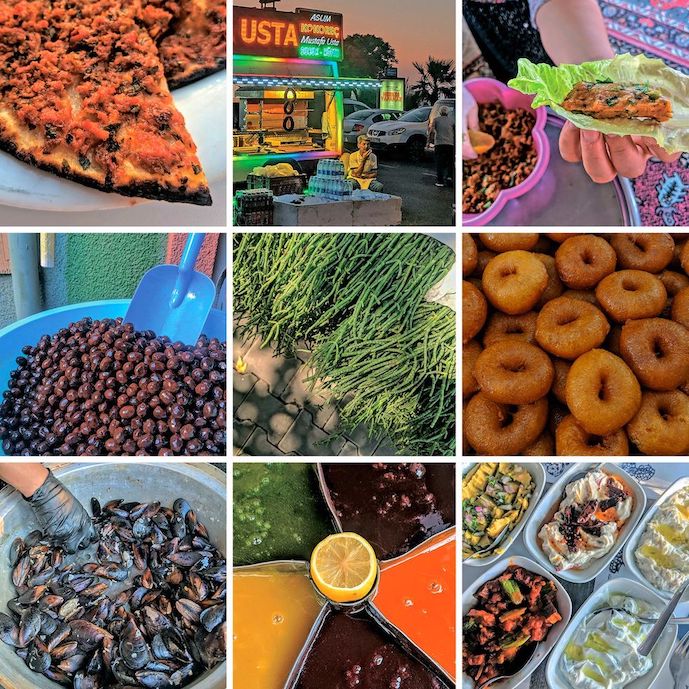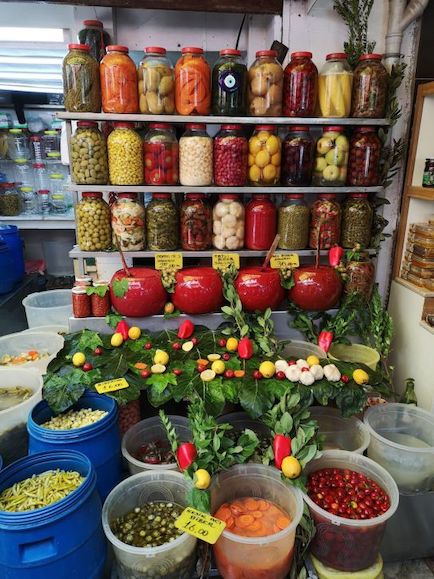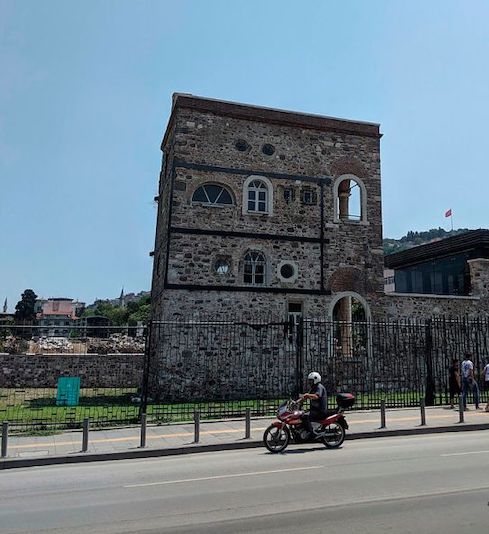
How a Jewish Pastry Became a Turkish City´s Iconic Street Snack
Although at first glance, Izmir isnt as beautiful as Istanbul, visitors there will discover a fascinating food culture which include a seriously addictive treat.
By Ronit Vered Aug 31, 2019 HAARETZ
Pomegranate and citrus trees grow in the cortejos (courtyard houses) of the old Jewish Quarter of Izmir, a city of some 4.25 million people on Turkey’s Aegean coast, formerly known as Smyrna. “Trees like this, whose fruit are part of Jewish religious ritual, are always an indication of a Jewish presence,” says Nüket Franco, a local culinary tour guide. In centuries past, Sephardi Jews sat in the shade of the pomegranate, lemon and citron trees here, having found refuge in the Ottoman Empire after being expelled from Spain and Portugal. At present, refugees and labor migrants from African countries and from Syria sit in the shade of those same trees.
Beginning in the 15th century, the Ottoman sultans granted haven to Jewish refugees when other kingdoms expelled or shut their gates to them. Even 600 years later, few countries, the Jewish state among them, allow the persecuted and the downtrodden to build a new life within their territory. For many of the latter-day refugees, Izmir is a way station to an unknown future. Most of them dream of obtaining legal visas to Canada or Europe; in the weeks ahead, some of them will probably try to make the perilous sea crossing to Europe illegally. (There are stores here selling used, pathetic-looking life jackets.)
The courtyard houses were built by Jews who fled the Inquisition. According to the designs and lifestyle they had been familiar with in the Iberian Peninsula: a shared, inner courtyard – spacious and hidden from the street, with running water and washing and cooking facilities – surrounded on all sides by two-story residences for poor families, without washrooms and kitchens.
“The Jews were ordered to leave their property behind in Spain,” Franco explains, “and many of the Jews who settled in Izmir were destitute at first. The courtyard houses were meant for people who couldn’t afford to buy a home of their own, and the fact that they lived together created solidarity and a sense of shared destiny.”
In recent years, some of these historic courtyard houses, as well as other buildings in the Juderia (Jewish Quarter) that were abandoned by their residents in the first half of the 20th century, have been turned into hostels and cheap hotels. Refugees from African countries and Syria live in them, exactly as the Jews did in their day. They sleep in as families in single rooms with balconies overlooking the courtyards, where they spend most of their waking hours, cooking, washing and doing laundry. The rent they pay is 20 Turkish lira a day ($2.85) – yet even that sum is too much for many of the newcomers.
Trauma and loss
We continue in the direction of one of Izmir’s lovely old tea houses in order to try the local çay (“tea,” in Turkish), a strong, black brew, in the shade of fig trees. In the early 20th century, proprietors of tea and coffee shops kept personal porcelain cups in glass cabinets for their regular clients. These days everyone uses standard glasses, but the cabinets – still containing dazzling collections of porcelain tea sets – still adorn the walls. Wooden chests hold packs of cards and boxes of Rummikub (a game that combines elements of rummy and mahjong), very popular among residents here.
Even in the broiling heat of August, a breeze from the bay reaches almost every corner of this hilly city. But it was also a pleasant wind that intensified the catastrophe one terrible day in mid-September 1922, during the Greco-Turkish War, when huge swathes of the city began to be consumed by flames that were only extinguished after nine days.

Izmir’s delicacies. Credit: Ronit Vered
Franco: “Because of the wind, the fire spread quickly. The ancient Muslim Quarter suffered less because of where it was located, but the other quarters, where Armenians, Greeks and Jews lived, were almost completely burned to the ground, and many of the residents fled. The Greek Christians were expelled as part of a population exchange between Greece and Turkey in 1923.”
The trauma and loss endured by communities that resided in Izmir for hundreds of years, and the eventual disappearance of many aspects of cultural-historical heritage, continue to resonate in Izmir to this day.
Franco, who comes from a Sephardi family whose roots are in Malaga, was born in Istanbul and only moved to Izmir in 1980, after she got married.
“Today I can no longer imagine life in Istanbul,” she says, with a smile. “Izmir is smaller, and if you live in the center you can get everywhere on foot. There’s a feeling of freedom here that you don’t find in other places. It’s still considered one of the most secular and most liberal cities in Turkey, even though in the past few decades large waves of immigration from southern and eastern Turkey have begun to change the composition of the population and also its political leanings. With the political shifts we are also getting many intellectuals and creative people, who are leaving Istanbul.”
In 2010, Franco and five other local women wrote and edited a cookbook of nearly 100 traditional recipes from Izmir’s Sephardi community. What began as a modest pamphlet in Turkish morphed in 2012 into an English-language book, “Izmir Sephardic Cuisine.”
“I come from a very secular family,” she explains, “but I was a volunteer in the League, a Jewish cultural center. We looked for creative ways to document and preserve the Jewish heritage and identity for the young generation. Many of the recipes in the book – which we collected from mothers, mothers-in-law, aunts and neighbors – are hardly ever used today. In some cases, because they are complicated and demand skills that have been lost; in others, because they do not fit in with current conceptions of nutrition.”
In the past two years, Franco has been guiding tours of Izmir through the worldwide Culinary Backstreets project (on which more below). Her fascinating six-hour tour focuses – like the tours the firm offers in other cities – on restaurants that feature home-style cooking, and on street-food stalls, small-scale food manufacturers and other hidden sites that are not easily accessible to tourists.
Izmir, at first glance, is not as beautiful as Istanbul. Many of the buildings in one of the world’s oldest and most fascinating cities were destroyed in wars that raged in the 20th century, and were hastily replaced – in a pattern familiar from Eastern Europe after World War II – with bland and dreary modern structures. The archaeological treasures of this city, an important port in the classical age, are displayed in an archaic style in museums empty of visitors that the authorities seem to lack any interest in (perhaps because the most intriguing exhibits attest to a past that is not consistent with the contemporary political narrative). But echoes of Izmir’s diverse cosmopolitan past, and of the life that existed here when it constituted an important commercial junction between East and West, can easily be gleaned from the culinary standpoint and the riveting food culture here.

Rafael Palombo's bottargo. Credit: Dan Perez
One of the city’s most interesting sites is the famous Kemeralti Market. This stunning Ottoman-era bazaar, which dates from Izmir’s golden age in the 17th century, sprawls across several square kilometers, from the ancient agora to the seaside wharf. It’s divided into sub-markets according to specialties: clothing, jewelry, kitchen utensils and knives, food, coffee and tea shops, and so on.
Nestled amid the tangle of alleys and khans are alluring culinary establishments: shops where elderly vendors still prepare cool, homemade sherbet; stalls selling semolina cookies, kaymak (a clotted-cream delicacy) and macun, a soft fruit toffee seasoned with honey and spices, whose origins are intertwined with the preparation of medications in antiquity; fresh fruit and vegetables of rare local varieties; restaurants featuring grilled foods (there are 291 types of dumplings in the Ottoman gastronomic universe, and in Izmir’s market I’m pretty sure I sampled the best of them); fish and shellfish restaurants; and eateries featuring homemade dishes that evoke the various minority communities that were an integral part of the city’s history.
Although Izmir lies on the shores of the Aegean and has a charming bay-side boardwalk, it has no sandy beaches. To bathe in the sea, locals and tourists travel to Çesme and other coastal towns, situated about half an hour’s drive away. The absence of beaches, together with the destruction wrought to the streets and buildings during the Greco-Turkish War a century ago, are among the reasons that Izmir has yet to become a major tourist destination. This is reflected not only in the neglected museums, but also in the fact that I was unable to find even one store selling English-language tourist guides or books about the city, past or present. The upside of all that is the low rates at hotels, even those on the water, and of course at the restaurants and food stalls.
Why Izmir?
One of the foods most associated with Izmir is boyoz, a round pastry of thin, oiled layers of flaky dough – a delightful delicacy that’s hard to find elsewhere. Sold at local bakeries and from peddlers’ carts, it’s eaten as is, without a filling, accompanied by tea and a hardboiled egg; alternatively, the pastry can be split open and eaten, sandwich-like, with cheese, tomato, spicy green peppers and olives. There’s no one who was born or lives in Izmir who isn’t familiar with the popular treat – but not everyone knows that its name comes from Ladino, the language of the Sephardi community that sought refuge in Ottoman lands after the expulsion from Spain.
Legend has it that the Jews of Izmir brought the pastry and the technique for preparing it from the Iberian Peninsula, and shared it with the Muslims and Christians of the Ottoman city. But the current version of boyoz sold in Izmir typically has no filling (the Jewish version includes a filling of cheese, spinach or eggplant, and is similar to what in Israel is called a “Turkish burekas”). The technique of flattening dough to a thin layer and creating layered pastries is associated more with the Turkish peoples of Central Asia. And if the original recipe was imported from Spain, we wonder, why is Izmiri boyoz different from pastries with the same name that are so popular among Sephardi Jewish communities elsewhere? And why did boyoz become a popular pastry that exceeded the boundaries of the Jewish community precisely in Izmir and not, say, in Istanbul?
The answers to these questions, as with other dishes that have a long and rich history, are both simple and complex. Foods change with time, though often they continue to bear the same name. Attempts to discover when the changes occurred or who is responsible for them, are generally doomed to failure. Local delicacies with ancient histories typically reflect the fraught transformations that have taken place in the lives of the people and the communities that prepare and consume them.
“When I interview older people whose family origins lie in Izmir, they tell me almost automatically that the Jews brought boyoz from Spain,” says Edna Assis, a culinary tour guide and researcher of Sephardi Jewish cuisine. “But I think that reaction also contains longing and nostalgia for the past. The food of an immigrant society never remains static. Jews ultimately adopted the cuisine of the cultures they lived among, with a slight adjustment for the kashrut laws and the rules for holidays and religious occasions. The Jews who arrived from Spain preserved certain elements of a Sephardi identity, but also underwent Ottomanization and acquired an Ottoman identity.”

Pickles on display in the market, Izmir. Credit: Ronit Vered
Nejat Yentürk, a Turkish journalist who recently published a comprehensive book about Izmiri street food, sees boyoz as a food for the destitute. In his telling, boyoz became a popular street food because the poor residents of the Judaria, the Jewish Quarter, sold it in the market area for their livelihood. The Jews could not afford to build bakeries or set up communal ovens, so they baked the boyoz in the ovens of their Muslim neighbors at the end of the workday. That explanation would account partially for how boyoz came to be favored by all the city’s residents and also, perhaps, for why the pastry became embedded in the collective consciousness as a doughy food without cheese or meat fillings – whose raw materials were more expensive and also more challenging in terms of kashrut.
These days, the boyoz sold on the streets and in the shops of Izmir are produced by semi-industrial bakeries or by professionals who specialize in the art of rolling out a wafer-thin sheet and folding it into a pocket of multiple thin layers.
“But there is not one commercial bakery in the city today that makes boyoz with filling in the Jewish style,” Franco says, adding that, “the young generations also rarely make it at home. There are a few elderly women who make it at home like in olden times and sell it privately.”
An Old City food tour
Culinary Backstreets was founded by two American journalists, Yigal Schleifer and Ansel Mullins, who both spent years in Istanbul and share a love of good street food and for restaurants where local culture is preserved by means of their cuisine. The two also run tours in other interesting gastronomic venues, including Beijing, Tokyo, Athens, Lisbon, Mexico City and more. Usually these are small groups whose guides offer – in addition to an invaluable list of addresses of local food outlets and eateries – rich historical-cultural information. A culinary tour of Izmir (including tastings and meals) costs $125.
Palombo Ticaret: The Jewish bottarga seller
For 55 years, nattily dressed Rafael Palombo, who speaks both Turkish and Ladino, has been selling bottarga (fish roe – actually, the dried and cured roe pouch of the gray mullet), yet there is no sign indicating the entrance to his shop. Its steel door is also always closed, and only people in-the-know will think to open it and enter the veteran establishment, located between the dark stone walls of an ancient khan. To demonstrate the quality of the bottarga – which is dried and cured in a workshop situated elsewhere, close to the sea – Palombo holds a pouch up to a lamp to underscore its transparency and color. “Good bottarga,” he says, “is prepared only from roe pouches from which the blood has been cleaned, and which were removed no more than an hour after the fish was caught.” (Anafartalar Cd. 228/14 Abacioglu Han)
Meshur Peynircilik: Two-year-old tulum
“Cheese is as important as bread in the state of Turkey, where if a person does not eat cheese for one day he already falls into great sorrow.” Those are the words of a Jewish sage in a 19th-century book of religiouso responsa – and he was so right. The Turkish nation does not boast hundreds of names of cheeses: Most are sold under generic names such as tulum, beyaz peynir and kashar. But each name is a world unto itself, encapsulating dozens or even hundreds of marvelous varieties, differentiated by where they were produced, the type of milk used, their saline level and the amount of time they were aged. This family-run shop, where three generations of experts work together, is a wonderful place for discovering Izmir’s cheeses. (929 Sok. no. 74 Havra Sokagi)
Abbas’in Yeri Konak: Chickpeas and meatballs
We stopped at a terrific lokanta (home-style restaurant) that offers a range of vegetarian and meat soups and dishes. Among the changing daily specials is a marvelous stew of whole chickpeas cooked in tomatoes and olive oil, served with meatballs no larger than the chickpeas. Arab culinary sources from medieval times describe tiny meatballs which only the small, skilled hands of women could prepare. Not until we saw and tasted this dish did we realize just how small they are. (902 Sok. no. 24 Hisaronu Kemeralti)
Fish & Steak House: Seafood and raki
Midye dolmasi, mussels stuffed with rice and served with fresh lemon, are a popular street food and a culinary symbol of Izmir. In the centrally located Alsancak quarter, not far from the fine wharf of Konak, is a boardwalk featuring dozens of fish restaurants crowded together that offer a seemingly similar menu of cold and hot mezes and grilled fish. At first glance, most of them look like tourist traps, and that’s not necessarily a wrong impression. However, Fish & Steak House is an excellent restaurant and a favorite of locals. In addition to a variety of fine mezes, we also ate there, on different occasions, balik Bugulama – a wonderful fish soup/stew with tomatoes, capers and potatoes; grouper wings; papalinas (Greek for “sprats,” which are fried), small fried fish; fresh shrimp roasted in an earthenware bowl with hot pepper butter; and whole fish cooked over a coal grill and served simply with arugula and lemon. A full meal for a couple, including a bottle of raki, costs about 400 Turkish lira, or $70. (Ataturk Cad. No: 174/1-A, 1. Kordon, 35220 Konak)
Meshur Kuyum Pide Salonu: Turkish flatbread
This is one of the best pide (flatbread) and lahmacun places in the market. (872 Sok. no. 72)

The building where Shabbetai Zvi is said to have been born, in Izmir, Turkey. Credit: Ronit Vered
At home with Shabbetai Zvi
The purpose of the Izmir Project, which was launched in 2010 by the Israel-based Kiriyaty Foundation, is to create an open museum encompassing the nine synagogues that remain in the Old City (somewhat like the route that features historic sites in the ancient Jewish Quarter of Prague). About 30 synagogues in total have survived in Izmir; with the oldest of them, dating from the 17th and 18th centuries, undergoing reconstruction and conservation in the past few years. The Izmir Project is being enthusiastically supported by a number of international and local agencies that realize the potential in encouraging Jewish historical tourism and perpetuating the community’s heritage, in general. Some of the synagogues undergoing a face-lift can already be visited. (A guided tour can be arranged here)
When it comes to Shabbetai Zvi – the charismatic 17th-century false messiah, who was born in Izmir and led his diehard Jewish believers to convert to Islam publicly in order to avoid death – there seems to be less interest in preserving his heritage. The Donmeh, descendants of his followers who continued to practice Judaism secretly, conceal their identity and are looked on askance by both Jews and Muslims. But if you emerge from Havra Sokagi street where most of the synagogues are located (as well as some of the most intriguing delicatessens and food stalls in the market) and head in the direction of the agora (where an archaeological dig is turning up findings from Roman-Byzantine times) – you can’t miss an ancient three-story building, which has undergone splendid renovation and restoration. It’s here that Shabbetai Zvi is believed to have been born.
Until recently, the structure was neglected and deserted, and it’s still not open to the general public. Like everything connected with the controversial personality of Shabbetai Zvi, the building itself has also given rise to a spate of juicy conspiracy theories.
“The renovation is governmental and municipal in nature, and has been carried out in the wake of a great many political disputes and much bureaucratic foot-dragging,” says Jacob Barnai, emeritus professor at the University of Haifa and an internationally renowned expert on the history of Turkey’s Jews. During a recent visit to Izmir this month, Barnai was given a rare private tour of the house.
“It’s built in typical 17th-century style,” he explains. "The tradition associating it with Shabbetai Zvi’s family – his father was the Levant agent of English merchants in Izmir – dates to the 19th century. According to what I was told, the building will be a municipal cultural center, where temporary exhibitions will be held and the story of Shabbetai Zvi will also be noted.”
Related Newsss ss













